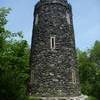







History
Mount Tom State Park was among the 15 parks created between 1913 and 1918 by Connecticut's first State Park Commission and was the first to open. The park's land had been donated in 1911 for use as a state park by Charles H. Senff. Following Senff's death, his widow, Gustavia A. Senff, saw the transfer of the property through to completion, with the state legislature finalizing the action in 1917.
Mount Tom Tower
A condition of the Senff gift was that a permanent observation tower be maintained at the summit of Mount Tom. The State Park Commission recommended that a stone tower be built to replace a wooden structure that had stood at the spot since 1888. The commission's secretary, Alfred M. Turner, drew up plans which were not closely followed when an unknown contractor constructed the tower of rough black gneiss found at the site. The tower stands 34 feet (10 m) high and 15 feet (4.6 m) in diameter; it was completed in 1921. Visitors can climb to the top for views that extend to Mount Everett in Massachusetts, the Catskills in New York, and Long Island Sound.
Geology
The park is notable for the presence of the metamorphic rocks gneiss and schist, the minerals quartz, garnet and hornblende, and boulders carried to the site by Ice Age glaciers.
Activities and amenities
Recreational activities include hiking the nearly one-mile-long loop trail that ascends Mount Tom to the observation tower, fishing, swimming and canoeing on Mount Tom Pond, and picnicking.
